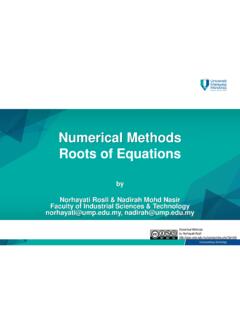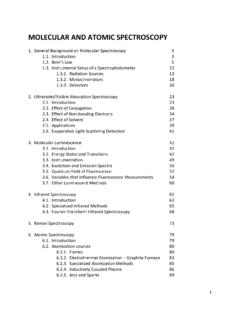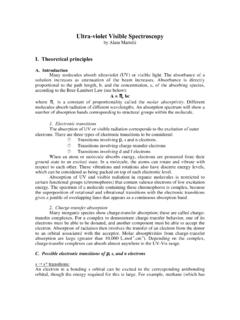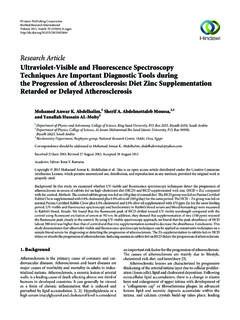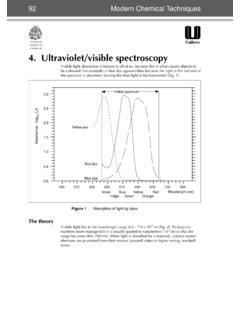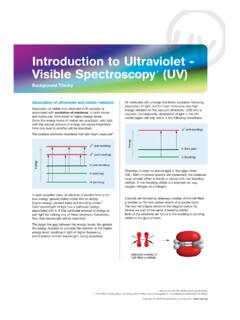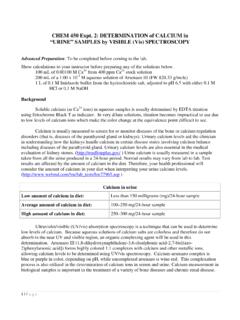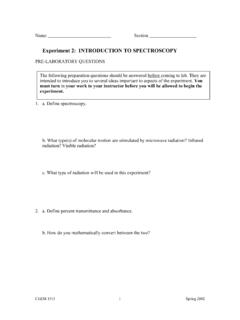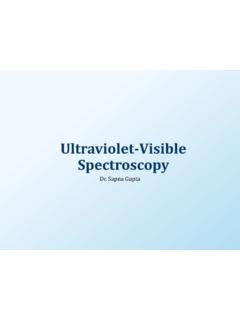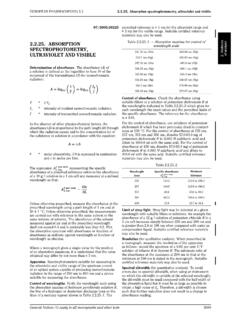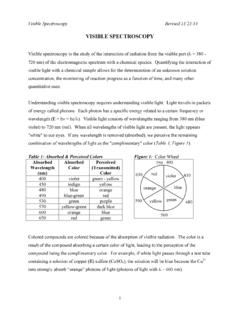Transcription of CHAPTER 2 ULTRAVIOLET-VISIBLE ABSORPTION …
1 CHAPTER 2 ULTRAVIOLET-VISIBLE ABSORPTION spectroscopy Expected Outcomes Able to discuss the interaction of electromagnetic waves with atomic and molecular species Describe the transmittance and absorbance State the functions of each components of instrumentation for optical spectroscopy Differentiate the type of optical instruments Describe the function of ULTRAVIOLET-VISIBLE instrument Electromagnetic spectrum 2 ~ Theory of Electromagnetic Radiation 3 Charged particles emit or absorb energy in a wavelike form known as electromagnetic radiation. This radiation consists of two components: an electric field and a magnetic field EM radiation travels at the speed of light, in a vacuum The basic unit of EM radiation is the photon, Theory of Electromagnetic Radiation Electromagnetic Radiation Wave properties: v = c c = velocity of light ( ms-1 in vacuum) = wavelength (m) v = frequency (cycles/s, cps, Hz) Particle properties (Photon energy) E = energy of quantum (J) h = Planck s constant ( x 10-34 ) v = frequency 4 ABSORPTION of Radiation The energy difference between the two energy states, E1 and Eo, must be equal to the energy of the absorbed radiation (E = hv).
2 5 E1 (excited state) E0 (ground state) Theory of Electromagnetic Radiation Atomic ABSORPTION When atoms absorb radiation, only e-s are excited. Line spectrum can be observed. Electronic transition - The transition of an e- between two orbitals. 6 Theory of Electromagnetic Radiation Molecular ABSORPTION Molecules undergo three types of quantized transitions when excited by ultraviolet , visible , & infrared radiation: Electronic transition Vibrational transition Rotational transition 7 Decrease in energy Theory of Electromagnetic Radiation 8 ABSORPTION of Radiation When light passes through an object, the object will absorb certain of the wavelengths, leaving the unabsorbed wavelengths to be transmitted. These residual transmitted wavelengths will be seen as a colour. The ABSORPTION can be detected by suitable detectors ABSORPTION and Emission 9 ABSORPTION and Emission nm Colour Complimentary ~180-380 UV - 400-435 Violet Yellow-green 435-480 Blue Yellow 480-490 Blue-green Orange 490-500 Green-blue Red 500-560 Green Purple 560-580 Yellow-green Violet 580-595 Yellow Blue 595-650 Orange Blue-green 650-750 Red Green-blue visible spectrum UV 10 Question?
3 Why is the red solution red? Because the object absorbs green component from the incoming white radiation and thus transmits red components. 11 A plot of the amount of radiation absorbed by a sample as a function of the wavelength is called an ABSORPTION spectrum ABSORPTION and Emission 12 ABSORPTION and Emission UV-VIS ABSORPTION spectrum for bromothymol avelength (nm)Absorbance13 ABSORPTION and Emission Emission of a photon occurs when an analyte in a higher energy state returns to a lower energy state. The higher energy state can be achieved by heat, photon and chemical reaction The emission of the sample itself provides the light and the intensity of the light emitted is a function of the analyte concentration. When molecules or atoms are in the excited state, they are very unstable and will lose their energy of excitation and drop back to a lower energy state or the ground state relaxation.
4 The excess energy is released in the form of electromagnetic radiation, heat, or both. 14 Po = initial radiant power P = final radiant power Transmittance: T = P / Po , % Transmittance: %T = P / Po x 100% Absorbance: Po P The Beer s Law bcTPPAo 1loglogL mol-1 cm-1 cm mol L-1 Transmittance & Absorbance 15 The Beer s Law Transmittance (T): the ratio of the radiant power (P) in a beam of radiation after it has passed through a sample to the power of the incident beam (Po). Absorbance (A) is also known as the optical density, = log (base 10) of the reciprocal of the transmittance (T). 16 What values of absorbance correspond to 100%T, 10%T, and 1%T? Exercise 2 Solution: 100%T, 10%T, and 1%T correspond to transmittances of , and From the definition of A: 100%T has A = -log1 = 0 10%T has A = = 1%T has A = = 17 A = Absorbance b = Optical path distance (cm) = Molar absorptivity (M-1cm-1) c = Concentration (M) The Beer s Law ABSORPTION of radiant energy When radiation of specified wavelength is passed through a solution containing only one solute which absorbs that wavelength, the absorbance (no units) can be calculated by: A = b c 18 Exercise 3 Monochromatic light was passed through a cm cell containing a solution of a given substance.
5 The absorbance obtained was Calculate the molar absorptivity of the substance. 19 0 0 2 4 6 8 10 Concentration Absorbance A = bc The Beer s law 20 Deviation from Beer s Law Non-linear curve may be obtained due to: limitations of Beer s law deviations deviations The Beer s Law 21 Concentration ABSORPTION Negative deviation Positive deviation Ideal Calibration Curve The Beer s Law 22 Fundamental limitations of Beer s law Beer s Law is only valid for: Low concentration of analyte. At high conc. (usually > ): the individual particles of analyte no longer behave independently of one another The absorbance changes - value of changed - deviation from Beer s Law High concentration of solute may result in a shift of maximum ABSORPTION , and may also change the value of the molar absorptivity.
6 The Beer s Law 23 depends on sample s refractive index (RI). Thus, may change at high conc but at low conc, RI remains essential constant. Calibration curve will be linear. 2. Chemical limitations of Beer s law Occur for absorbing species that are involved in an equilibrium reaction. For example in the case of weak acid and conjugate base The Beer s Law 24 Example Benzoic acid exists as a mixture of ionised and unionised form: C6H5 COOH + H2O C6H5 COO- + H3O+ ( max = 273 nm) ( max = 268nm) In higher dilution, or higher pH, more ionised benzoate is formed, thus the absorbance at 273nm decreases. On the other hand, at lower pH, benzoic acid remains in its unionised form whereby the absorbance at 273 nm is optimised. The Beer s Law 25 A Conc 273nm 268nm The Beer s Law 26 3.
7 Instrumental deviations Beer s law is only valid for monochromatic radiation. The output from a continuous source (D2 lamp) will always produce a specific band width (about +5 nm). 220 nm may imply 215 to 225 nm The Beer s Law 27 Components of Instrumentation for Optical spectroscopy Source Monochromator Sample Detector Meter 28 Components of Instrumentation for Optical spectroscopy Components Most spectroscopic instruments are made up of : 1. source 2. wavelength selector 3. sample container 4. detector 5. signal processor and readout ~courses/undrgrad/221/www board/handouts/ 29 Components of Instrumentation for Optical spectroscopy Spectroscopic sources A good radiation source should have the following characteristics : the beam emits radiation over a wide range of the spectrum. sufficient intensity to be detectable.
8 Stable 30 Components of Instrumentation for Optical spectroscopy Line source consists of one or more very narrow bands of radiation whose wavelengths are known exactly (Hollow cathode lamp) Continuous source produces radiation of all wavelengths within a certain spectral region (D2 lamp) 31 Components of Instrumentation for Optical spectroscopy Source of radiant energy for: visible region: tungsten filament lamp UV region: deuterium discharge lamp (D2) (a) A tungsten lamp. (a) A deuterium lamp. [Picture taken from Analytical Chemistry by Gary D. Christian Page 530 and 531] 32 Components of Instrumentation for Optical spectroscopy Wavelength selector Monochromator (Monochrome = one colour ) to spread out or disperse light into its component wavelengths and select the required wavelength for analysis. 33 Components of Instrumentation for Optical spectroscopy Function of monochromator Restricts the wavelength that is to be used to a narrow band Enhance the selectivity and sensitivity of an instrument Narrow bandwidth => better adherence to Beer s law Not possible to produce radiation of a single wavelength 34 Components of Instrumentation for Optical spectroscopy Components of a monochromator: Entrance slit (restrict unwanted radiation) Dispersing element (separate the wavelengths of the polychromatic radiation) prism reflection grating Exit slit adjustable (control the width of the band of wavelengths) 35 Components of Instrumentation for Optical spectroscopy Bunsen prism monochromator [Picture taken from Fundamentals of Analytical Chemistry by Douglas A.]
9 Skoog, Donald M. West and F. James Holler Page 536] 36 Components of Instrumentation for Optical spectroscopy Grating Monchromator [Pcture taken from Modern Analytical Chemistry by David Harvey, pg 378] 37 Components of Instrumentation for Optical spectroscopy Sample container Must be transparent in the wavelength region being measured UV-VIS spectroscopy UV region: cell or cuvette of quartz VIS region: cell or cuvette of quartz/glass/plastic 38 Components of Instrumentation for Optical spectroscopy Cells should be optically matched (in pair). Selection of cells depends on: - wavelength of radiation used - amount of sample available - nature of sample liquid (aqueous / organic) or gas 39 Components of Instrumentation for Optical spectroscopy Size of curvette = 1cm x 1cm (square base) Volume used= to 2ml depending on the sample size.
10 Some typical UV and visible ABSORPTION cells [Picture taken from Analytical Chemistry by Gary D. Christian Page 427] 40 Components of Instrumentation for Optical spectroscopy Detector Photons are detected by: Photoemission or Photoconduction All photon detectors are based on the interaction of radiation with a reactive surface to produce electrons (photoemission) or to promote electrons to energy states in which they can conduct electricity (photoconduction). Only UV, visible and near-IR radiation have sufficient energy to cause these processes to occur. 41 Components of Instrumentation for Optical spectroscopy Photomultiplier tubes A photomultiplier contains a photo-emissive cathode and several anodes (dynodes) in a vacuum. The cathode is coated with an easily ionized material such as alloys of alkali metals (K, Na, Ca, Mg) with Sb, Bi and / or Ag.


